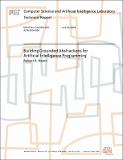Building Grounded Abstractions for Artificial Intelligence Programming
Author(s)
Hearn, Robert A.
DownloadMIT-CSAIL-TR-2004-040.ps (43.32Mb)
Additional downloads
Metadata
Show full item recordAbstract
Most Artificial Intelligence (AI) work can be characterized as either ``high-level'' (e.g., logical, symbolic) or ``low-level'' (e.g., connectionist networks, behavior-based robotics). Each approach suffers from particular drawbacks. High-level AI uses abstractions that often have no relation to the way real, biological brains work. Low-level AI, on the other hand, tends to lack the powerful abstractions that are needed to express complex structures and relationships. I have tried to combine the best features of both approaches, by building a set of programming abstractions defined in terms of simple, biologically plausible components. At the ``ground level'', I define a primitive, perceptron-like computational unit. I then show how more abstract computational units may be implemented in terms of the primitive units, and show the utility of the abstract units in sample networks. The new units make it possible to build networks using concepts such as long-term memories, short-term memories, and frames. As a demonstration of these abstractions, I have implemented a simulator for ``creatures'' controlled by a network of abstract units. The creatures exist in a simple 2D world, and exhibit behaviors such as catching mobile prey and sorting colored blocks into matching boxes. This program demonstrates that it is possible to build systems that can interact effectively with a dynamic physical environment, yet use symbolic representations to control aspects of their behavior.
Date issued
2004-06-16Other identifiers
MIT-CSAIL-TR-2004-040
AITR-2004-004
Series/Report no.
Massachusetts Institute of Technology Computer Science and Artificial Intelligence Laboratory
Keywords
AI, Artificial Intelligence, Society of Mind, Multi-Agent Systems